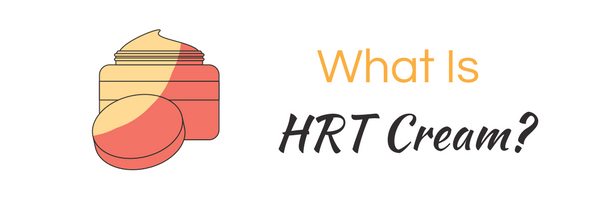
Let’s walk through the basics of HRT in general, and take a glimpse at HRT cream.
First thing’s first, what is HRT in plain English?
What Is HRT?
Hormone replacement therapy (HRT) is a term that’s being used less often and gradually being replaced by just hormone therapy (HT).
Despite this, the term HRT still remains relatively common so we will use the term HRT throughout today’s look at HRT cream.
HRT is a treatment commonly used to boost the body’s natural hormone levels.
This therapy helps to make sure estrogen and progesterone levels are properly balanced. Menopause causes the amount of estrogen and progesterone in the ovaries to plummet. This is what brings on most of the symptoms of menopause.
Women experiencing menopause are treated using estrogen with progestogen therapy (EPT). Progestogen is a synthetic version of progesterone, a naturally occurring hormone. (1)
Women who have had a hysterectomy or undergone surgical menopause often follow estrogen-only therapy (ET).
Hormone replacement therapy can alleviate many of the symptoms of menopause including hot flashes and excess sweating. HRT can also reduce the risk of osteoporosis if treatment is ongoing. (2)

What Types of HRT Can a Doctor Prescribe?
There are 5 main preparations for hormone replacement therapy.
Your doctor can advise you in depth on the upsides and drawbacks of each.
- HRT Tablets: Tablets taken daily is one of the most common methods of taking HRT. Both estrogen-only and estrogen-progestogen HRT tablets are available. The risk of blood clots increases slightly with tablets when compared with other preparations. (3)
- HRT Cream: Estrogen also comes in the form of an HRT cream that is placed inside the vagina. While this can mitigate dryness, it will not help symptoms like hot flashes. For this reason, HRT cream is most frequently suggested for postmenopausal women who have not had a period for 2 months. This method carries none of the risks of HRT and can be safely used without progestogen. (4)
- Skin Patches: Patches stuck to the skin and replaced every few days are available in both estrogen-only form and also as combined HRT patches. If you struggle taking tablets, patches are a smart alternative. Patches carry no risk of blood clots and they can help with indigestion and other unpleasant side effects of menopause.
- Estrogen Gel: Growing in popularity, estrogen gel is applied to the skin daily and easily absorbed. Gel is an effective approach to taking HRT while sidestepping an increased risk of blood clots. If your womb is still intact, it’s a wise move to take a supplement of progestogen to lessen any chance of womb cancer. (5)
- Implants: You can have HRT implants popped under your skin so that estrogen is released gradually over the course of a few months. You are also well advised to take progestogen if you have your womb. This is an option worth considering if you find it difficult to maintain regular treatment.
There are 2 different courses of treatment available:
- Continuous Combined HRT
- Sequential HRT
Continuous HRT
Usually recommended for post-menopausal women, with this therapy you take estrogen and progestogen daily without a break.
Estrogen-only therapy is also generally taken continuously.

Sequential HRT
If you have symptoms of menopause but you’re still menstruating, sequential HRT, also known as cyclical HRT, is normally recommended.
- Regular Periods: Take estrogen daily then add progestogen for the final 14 days of your menstrual cycle
- Irregular Periods: Take estrogen daily then take progestogen for 14 days every 3 months or so
How Do You Apply HRT Cream?
If you’re looking to relieve symptoms occurring after menopause, HRT cream is perhaps something you have considered.
For anyone suffering from vaginal dryness, itching, cystitis or incontinence, using HRT cream might be beneficial.
You’ll need a prescription and you’ll need to check with your doctor if this is the best course of HRT for your needs. There’s no substitute for speaking with your healthcare provider.
Now let’s look at how to apply this cream.
It couldn’t be much simpler, and there will be instructions with the prescription:
- Take the cap off the tube and invert it. Open the tube with the sharp point
- Attach the applicator and make sure the plunger is in the barrel
- Slowly squeeze the tube. The applicator should be filled to the mark
- Separate the applicator and the tube
- Lie down and insert applicator into the vagina
- Push plunger slowly until the applicator is empty
- Disassemble the plunger and barrel. Wash in warm soapy water but avoid any detergents

What Are The Positives and Negatives of Using HRT In Any Form?
We’ll round out with a brief summary of the overall advantages and drawbacks of hormone replacement therapy in general.
Pros
- Estrogen therapy can reduce or even eliminate hot flashes, poor sleep and vaginal dryness
- HRT is normally completely safe (if used for five years), and research is being updated constantly to extend that timeline
- Can help to lessen risk of colon cancer
- Effective method of combating bone loss
Cons
- Using estrogen without progestogen can lead to an increased risk of uterine cancer
- Hormone replacement tablets can slightly increase the risk of heart disease, stroke and breast cancer
- If you’re using HRT to attack osteoporosis, there are other non-hormonal medications available
- The current guidelines say it is not suitable for long-term use (but again the research is constantly changing on this)
This study makes it clear the risks and benefits are not clear-cut so use the above as a guideline only. (6)
Citations
- http://www.bio-hormone-health.com/2012/08/10/progesterone-or-progestogen-why-they-are-not-the-same/
- https://www.ncbi.nlm.nih.gov/pubmed/15785435
- https://www.ncbi.nlm.nih.gov/books/NBK343458
- https://www.ncbi.nlm.nih.gov/pmc/articles/PMC3897322
- https://www.ncbi.nlm.nih.gov/pmc/articles/PMC4217555
- https://www.ncbi.nlm.nih.gov/pubmed/15261840



